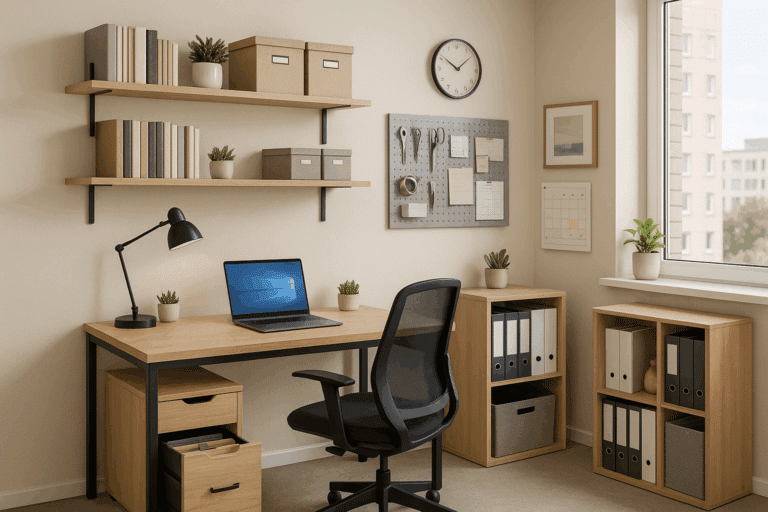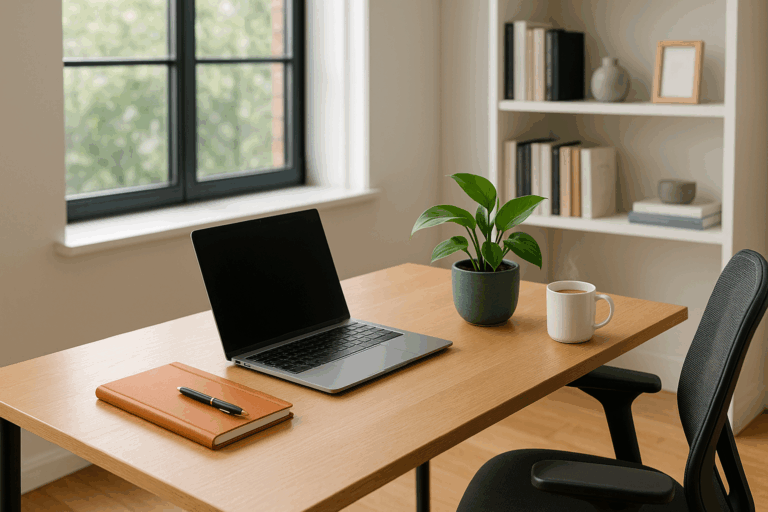So, you’ve decided to take a leap into the world of ergonomics, seeking a solution for those countless hours of sitting, which are causing a toll on your health and well-being. You’re not alone! More and more professionals are adopting the innovative solution of standing desks. But, you might be asking yourself, are standing desks genuinely healthier than their sitting counterparts? How to choose between the two? What factors should you consider? 🤔
In this comprehensive guide, we’ll take a deep dive into the world of standing desks and sitting desks, exploring the benefits, drawbacks, and key differences that should guide your decision. We’ve got you covered, whether you’re a software engineer, a writer, a graphic designer, or anyone spending a significant chunk of their day at a desk. Ready to make an informed choice for a healthier workday? Let’s get started! 🚀
Now, one might argue that humans have been sitting for work for centuries, so why change? The reality is, our bodies weren’t designed for the amount of sitting that modern-day office life entails. The adage ‘sitting is the new smoking’ holds some truth, with research linking prolonged sitting to numerous health problems. So, what’s the solution? Enter, standing desks!👏
Standing desks are quickly becoming the go-to solution for health-conscious professionals. But, as with any new trend, there are misconceptions, unfounded fears, and a lot of questions. Is standing for long hours healthy? Are there any risks involved? We’ll answer these questions, providing you with accurate, research-backed information. We’ll also share some useful tips on how to properly use a standing desk to maximize its benefits.
Of course, we aren’t declaring the demise of the traditional sitting desk just yet. Sitting desks, especially those designed with ergonomics in mind, still have their place in our offices and homes. We’ll look into the benefits and potential drawbacks of these desks too, enabling you to see both sides of the coin. Because, ultimately, the choice between a standing desk and a sitting desk should be about what suits your specific needs and work habits the best.😊
So, buckle up as we explore everything there is to know about standing desks and sitting desks. From the potential health benefits and risks to tips for adjusting to a standing desk, to considerations when shopping for your perfect desk. By the end of this guide, we aim to equip you with the knowledge to make a decision that will positively impact your health, productivity, and overall work experience. 🌟
Remember, the goal isn’t necessarily to stand all day but to create a work environment that encourages movement, correct posture, and a healthier lifestyle. The standing desk vs sitting desk debate is not about choosing one extreme over the other; it’s about finding a balance that works for you. After all, the key to a healthier workday lies not just in our furniture but in how we use it. So, let’s get started on your journey to a healthier workday! 💪
Striking a Balance: Understanding Standing Desks and Sitting Desks
In the modern workplace, ergonomics plays a crucial role. As professionals spend more time at their desks, the choice between a standing desk and a sitting desk can impact not only productivity but also health. In this detailed guide, we will delve into the specifics of both options, their advantages, and how to choose the best fit for you.
Video Title: Sitting vs. Standing Desks: Which is better? Channel: Tech Insider. This video offers an engaging visual representation of the impact of standing and sitting desks on health and productivity.
Standing Desks: Standing Tall in the Workplace
Standing desks have gained popularity over the years, thanks to the potential health benefits they offer. But, what exactly does a standing desk bring to the table?
Research suggests that standing desks can contribute to weight loss, better posture, and decreased risk of heart disease. It’s not just about the physical benefits though. Standing desks can also enhance focus, productivity, and overall work performance. For individuals dealing with back pain or other physical discomforts while working, a standing desk could be a game-changer.
However, it’s essential to understand that standing all day isn’t the answer either. Extended periods of standing can lead to discomfort and other issues like varicose veins. Therefore, the ideal approach is to balance between sitting and standing throughout the workday.
Sitting Desks: The Traditional Work Companion
The sitting desk has been a fixture in workplaces for decades. It’s the traditional choice, and there’s a reason it’s stuck around: convenience and comfort. It’s easier to sit and work for extended periods, especially for tasks that require intense concentration.
However, we have all heard the phrase, “sitting is the new smoking.” Extended sitting periods can lead to a host of health issues, including obesity, diabetes, cardiovascular diseases, and musculoskeletal disorders. Therefore, it’s essential to take regular breaks, stretch, and move around to offset these potential risks.
Again, balance is key. Just as with standing desks, incorporating movement into your workday is vital, even if you’re using a sitting desk.
Stand or Sit: A Comparative Analysis
Now that we have a grasp on standing and sitting desks let’s dive into a comparative analysis. The choice isn’t about good or bad but more about finding what suits your needs best.
| Features | Standing Desk | Sitting Desk |
|---|---|---|
| Health Benefits | May reduce the risk of obesity, heart disease, and improve posture | No direct health benefits |
| Comfort | May take time to get used to standing while working | Comfortable for long periods, familiar |
| Productivity | Can increase focus and energy levels | May promote concentration for detailed tasks |
Adjustable Desks: The Best of Both Worlds?
Adjustable desks have become increasingly popular. They offer the flexibility to switch between sitting and standing. This way, you can enjoy the benefits of both without the drawbacks. However, keep in mind that these desks can be more expensive than their static counterparts.
Video Title: Flexispot Adjustable Desk Review – Standing Desk On A Budget. Channel: Geek Street. This review provides an in-depth look at a popular adjustable desk option.
An adjustable desk can be a great investment for those who are unsure about committing to a standing or sitting desk. It offers the freedom to adjust based on your tasks, comfort, and energy levels throughout the day.
Considerations When Choosing Your Desk
Before deciding between a standing desk, a sitting desk, or an adjustable desk, consider your work style, health needs, and budget. Take into account your daily tasks – do they require long hours of focus, or are they more dynamic? Do you have any health issues that could be affected by your choice? And of course, what desk fits into your budget?
Once you’ve considered these factors, you’re well on your way to making an informed decision that will contribute to a healthier workday.
Remember, it’s not just about standing or sitting – it’s about movement. Whichever desk you choose, make sure to incorporate regular breaks to move, stretch, and rest your eyes. A balanced approach is always the healthiest one. 🏋️♂️💼👩💻

Conclusion
Having traversed the spectrum of knowledge and understanding that this article offers, we must recap the salient features and insights we gained. We dissected several complex aspects of Software Engineering, and I hope the content was both enriching and comprehensible.
Let’s delve into the highlights of our discourse. We began by understanding the importance of Software Engineering and its role in today’s tech-driven world 🌐. We then moved on to discuss the fundamental principles of this field, ranging from Requirement Engineering to Software Design and Architecture, Software Coding, Testing, and Maintenance.
Each phase is integral to the software development life cycle. An important concept we emphasized was the value of meticulous Requirement Engineering. Gathering precise requirements is the backbone of any successful project, as it lays the blueprint for all subsequent phases.
We ventured into Software Design and Architecture, explaining how a well-structured design ensures the efficiency, reliability, and robustness of software systems. An insightful discussion on coding expounded on how good coding practices can significantly impact the software’s functionality and maintainability.
The testing phase was elaborated in great detail, highlighting its significance in identifying and rectifying software bugs. Finally, the importance of regular maintenance in ensuring the long-term health and efficiency of software systems was emphasized.
Software Engineering is a vast field with an array of fascinating facets, and this article endeavored to offer an overview of some of the most crucial aspects. The knowledge is not merely theoretical; it holds immense practical value for anyone engaged in software development. The insights shared here can provide the foundation for efficient software development practices and contribute to the creation of high-quality, robust software systems 💻.
I invite you to dive deeper, explore more, and continue learning. You can find further reading and resources here ACM Digital Library and here IEEE Xplore to augment your knowledge.
The world of software engineering is exciting and ever-evolving. It is a field that can truly transform our lives, and hence, understanding it and mastering its principles is of paramount importance. I trust this article has served as a stepping stone towards that understanding. Please feel free to leave your comments, share your thoughts, or ask any questions you may have. Sharing knowledge and engaging in discussions is an excellent way to learn and grow 🚀.
Let’s strive to apply the knowledge gained, improve our practices, and work towards developing superior software systems. After all, as engineers, our ultimate goal is to create systems that improve lives and make the world a better place. Stay inspired, keep learning, and let’s continue to make a difference, one line of code at a time.
Remember, it’s not about being perfect, it’s about being a little better every day! 😊
Remember to share this article with your colleagues, friends, or anyone who might benefit from it. Sharing knowledge is a great way to give back to the community.
Happy coding, and till next time!



